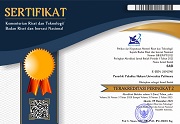Arrangements Concerning Reclamation and Their Legal Impacts in View from UNCLOS 1982
 ), Richard Marsilio Waas(2), Afrizal Anshari Makatita(3)
), Richard Marsilio Waas(2), Afrizal Anshari Makatita(3)
(1) Faculty of Law Pattimura University, Ambon, Indonesia
(2) Faculty of Law Pattimura University, Ambon, Indonesia
(3) Faculty of Law Pattimura University, Ambon, Indonesia
 Corresponding Author
Corresponding Author
Abstract
Introduction: Continuous development in a country automatically makes the country lack vacant land, and reclamation is one way to overcome this problem. Reclamation in its implementation has not been regulated in detail in the 1982 UNLCOS so it can cause problems in the future, such as what happened in the South China Sea where China carried out reclamation in the Spratly archipelago.
Purposes of the Research: To find out and analyze reclamation arrangements in the 1982 UNCLOS and the impact of reclamation laws carried out by countries in terms of the 1982 UNCLOS.
Methods of the Research: This study uses a normative juridical research type. By using the statutory approach, case approach, and conceptual approach. Management and analysis of legal material in this study use qualitative analysis.
Results of the Research: The results showed that the 1982 UNCLOS did not regulate coastal reclamation, but there were several articles in the 1982 UNCLOS that related to coastal reclamation and could be used as a basis, namely Article 11, Article 12, Article 56, and Article 60. The impact of reclamation for the delimitation of sea areas between countries is that the state will take its own way of understanding and interpreting the contents of the convention for its own benefit, one of which is to carry out reclamation which can lead to delimitation disputes, especially in areas where an agreement on territorial boundaries has not been established as happened in reclamation disputes in the Spratly Islands. in the South China Sea by China.Keywords
DOI
10.47268/sasi.v29i4.1790
Published
2023-12-18
How To Cite
@article{SASI1790,
author = {Popi Tuhulele and Richard Waas and Afrizal Makatita},
title = {Arrangements Concerning Reclamation and Their Legal Impacts in View from UNCLOS 1982},
journal = {SASI},
volume = {29},
number = {4},
year = {2023},
keywords = {Reclamation; Legal Impact; UNCLOS 1982.},
abstract = {Introduction: Continuous development in a country automatically makes the country lack vacant land, and reclamation is one way to overcome this problem. Reclamation in its implementation has not been regulated in detail in the 1982 UNLCOS so it can cause problems in the future, such as what happened in the South China Sea where China carried out reclamation in the Spratly archipelago.Purposes of the Research: To find out and analyze reclamation arrangements in the 1982 UNCLOS and the impact of reclamation laws carried out by countries in terms of the 1982 UNCLOS.Methods of the Research: This study uses a normative juridical research type. By using the statutory approach, case approach, and conceptual approach. Management and analysis of legal material in this study use qualitative analysis.Results of the Research: The results showed that the 1982 UNCLOS did not regulate coastal reclamation, but there were several articles in the 1982 UNCLOS that related to coastal reclamation and could be used as a basis, namely Article 11, Article 12, Article 56, and Article 60. The impact of reclamation for the delimitation of sea areas between countries is that the state will take its own way of understanding and interpreting the contents of the convention for its own benefit, one of which is to carry out reclamation which can lead to delimitation disputes, especially in areas where an agreement on territorial boundaries has not been established as happened in reclamation disputes in the Spratly Islands. in the South China Sea by China.},
issn = {2614-2961}, pages = {813--825} doi = {10.47268/sasi.v29i4.1790},
url = {https://fhukum.unpatti.ac.id/jurnal/sasi/article/view/1790}
}
Journal Article
Azizah Siti, 2016, Pengaturan Tentang Reklamasi Pantai Berdasarkan UNCLOS 1982 dan Impelementasinya di Indonesia, Jurnal Yuridis. vol. 3, no. 2, 49-60
Sadeghi Kabir, 2007, An Overview of Design, Analysis, Construction and Installation of Offshore Petroleum Platforms Suitable to Cypress/Oil Gas, GAU, J. Soc. & Appl. Sci, 2(4), 1-16
Indrawan Satria Try, dkk, 2016. " Reklamasi Pulau Republik Rakyat Tiongkok di Laut Cina Selatan: Suatu Analisis Terhadap Status Penambahan Wilayah dan Dampak Terhadap Jalur Pelayaran Internasional" Jurnal Undip, Volume 5, No.2
Tuhulele Popi, Pengaruh Keputusan Mahkamah Internasional Dalam Sengketa Pulau Sipadan dan Ligitan Terhadap Penetapan Garis Pangkal Kepulauan Indonesia, Jurnal Sasi Vol. 17 No. 2 Bulan April - Juni 2011, 61-72
Yudha Wisnu AR, 2007, Reklamasi Singapura Sebagai Potensi Konflik Delimitasi Perbatasan Wilayah Indonesia-Singapura, Global & Strategies.Vol I No 2, 120-137
Adi Wahyu Setyo Danang, Analisis Penyelesaian Sengketa Laut China Selatan Oleh Badan Arbitrase Internasional (Analysis of Settlement of South China Sea Disputes by The Internasional Arbitration Agency), Rewang Rencang : Jurnal Hukum Lex Generalis, Vol. 2 No. 1, 2021, 1-13
Book
Masyhur Effendi, Moh. Ridwan, 1995, Muslich Subandi, Pengantar dan Dasar-Dasar Hukum Internasional, Malang: IKIP Malang, 1995
I Made Andi Arsana, 2007, Batas Maritim Antar Negara: Sebuah Tinjauan Teknis dan Yuridis, Yogyakarta: Gadjah Mada University Press
Chairul Anwar, Hukum Internasional : Horison baru Hukum Laut Internasional. Jakrata: Djambatan, 1989
Thesis, Web Page, and Others
Nguyen Thu Giang, 2016, Land Reclamation In The South China Sea: Possibility Of Invoking Judicial Dispute Settlement Mechanism, Faculty of Law, International Law, Universiteit Gent, Ghent.| Dublin Core | PKP Metadata Items | Metadata for this Document | |
| 1. | Title | Title of document | Arrangements Concerning Reclamation and Their Legal Impacts in View from UNCLOS 1982 |
| 2. | Creator | Author's name, affiliation, country | Popi Tuhulele; Faculty of Law Pattimura University, Ambon; Indonesia |
| 2. | Creator | Author's name, affiliation, country | Richard Marsilio Waas; Faculty of Law Pattimura University, Ambon; Indonesia |
| 2. | Creator | Author's name, affiliation, country | Afrizal Anshari Makatita; Faculty of Law Pattimura University, Ambon; Indonesia |
| 3. | Subject | Discipline(s) | |
| 3. | Subject | Keyword(s) | Reclamation; Legal Impact; UNCLOS 1982. |
| 4. | Description | Abstract | Introduction: Continuous development in a country automatically makes the country lack vacant land, and reclamation is one way to overcome this problem. Reclamation in its implementation has not been regulated in detail in the 1982 UNLCOS so it can cause problems in the future, such as what happened in the South China Sea where China carried out reclamation in the Spratly archipelago.Purposes of the Research: To find out and analyze reclamation arrangements in the 1982 UNCLOS and the impact of reclamation laws carried out by countries in terms of the 1982 UNCLOS.Methods of the Research: This study uses a normative juridical research type. By using the statutory approach, case approach, and conceptual approach. Management and analysis of legal material in this study use qualitative analysis.Results of the Research: The results showed that the 1982 UNCLOS did not regulate coastal reclamation, but there were several articles in the 1982 UNCLOS that related to coastal reclamation and could be used as a basis, namely Article 11, Article 12, Article 56, and Article 60. The impact of reclamation for the delimitation of sea areas between countries is that the state will take its own way of understanding and interpreting the contents of the convention for its own benefit, one of which is to carry out reclamation which can lead to delimitation disputes, especially in areas where an agreement on territorial boundaries has not been established as happened in reclamation disputes in the Spratly Islands. in the South China Sea by China. |
| 5. | Publisher | Organizing agency, location | Faculty of Law, Universitas Pattimura |
| 6. | Contributor | Sponsor(s) | |
| 7. | Date | (YYYY-MM-DD) | 2023-12-18 |
| 8. | Type | Status & genre | Peer-reviewed Article |
| 8. | Type | Type | |
| 9. | Format | File format | |
| 10. | Identifier | Uniform Resource Identifier | https://fhukum.unpatti.ac.id/jurnal/sasi/article/view/1790 |
| 10. | Identifier | Digital Object Identifier | 10.47268/sasi.v29i4.1790 |
| 11. | Source | Title; vol., no. (year) | SASI; Volume 29 Issue 4, December 2023 |
| 12. | Language | English=en | en |
| 13. | Relation | Supp. Files | |
| 14. | Coverage | Geo-spatial location, chronological period, research sample (gender, age, etc.) | |
| 15. | Rights | Copyright and permissions | Copyright: Authors who publish their manuscripts in this Journal agree to the following conditions: 1. The copyright in each article belongs to the author, as well as the right to patent. 2. Authors can enter into separate, additional contractual arrangements for the non-exclusive distribution of the journal's published version of the work (e.g., post it to an institutional repository or publish it in a book), with an acknowledgment of its initial publication in this journal. 3. Authors are permitted and encouraged to post their work online (e.g., in institutional repositories or on their website) before and during the submission process, as it can lead to productive exchanges, as well as earlier and greater citation of published work. 4. Authors have the right to self-archiving of the article (Author Self-Archiving Policy)
License: The SASI Journal is disseminated based on the Creative Commons Attribution-NonCommercial 4.0 International license terms. This license allows anyone to copy and redistribute this material in any form or format, compose, modify, and make derivatives of this material for any purpose. You cannot use this material for commercial purposes. You must specify an appropriate name, include a link to the license, and certify that any changes have been made. You can do this in a way that is appropriate but does not imply that the licensor supports you or your use.
|
Copyright (c) 2023 Popi Tuhulele, Richard Marsilio Waas, Afrizal Anshari Makatita

This work is licensed under a Creative Commons Attribution-NonCommercial 4.0 International License.

 : 2056 times
: 2056 times Download : 1439 times
Download : 1439 times
















